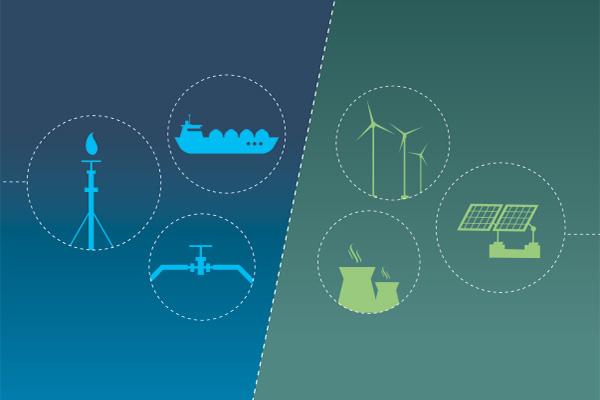
EU gas and electricity markets made considerable progress in 2023 in diversifying supplies, incorporating more renewables and returning to stable, more affordable prices after the energy crisis of 2022, according to the reports for the 4th quarter of 2023, which were published today.
Completing the picture for developments in 2023, the reports highlight that overall gas consumption was 7% lower than in 2022 and 20% lower than in 2021. Linked to this, overall imports of Russian gas dropped to 43 billion cubic meters (bcm), relative to 79 bcm in 2022 and 150 bcm in 2021. At the same time, the share of electricity generated by renewables (44%) overtook the share from fossil fuels (32%) for the first time.
The gas market report underlines the strengthened LNG imports, sustained robust gas storage levels and lower gas consumption, which resulted in lower import demand and the return of wholesale prices to historic levels and a moderation of retail prices. Overall imports in the calendar year declined to 290 bcm in 2023, 13% less than in 2022 (335 bcm) and 14% less than in 2021 (336 bcm) – with the share of imports as LNG reaching 41% in the last quarter. The most important suppliers were Norway (30%), U.S. (19%), Russia (15%), North-Africa (14%), UK (6%), Qatar (5%), Azerbaijan (4%) and Nigeria (3%). The share of LNG imports from the U.S. increased both annually and quarterly, reaching up to 50% in the last quarter of the year.
EU gas storage levels reached new record highs in 2023 with the average gas storage filling rate reaching 30% higher than in 2022 and 49% higher than in 2021. The average filling rate in Q4 2023 was 95%, 8% higher than in the previous quarter. The report notes that gas consumption in the last quarter of 2023 in fact rose by 71% (to 96 bcm) relative to the previous quarter, reflecting the seasonally higher winter demand.
Domestic gas production further declined, both annually and quarterly, covering only 11% of the EU’s consumption in 2023. In 2023, the annual production was 38 bcm, 20% lower than in 2022 and 26% lower than in 2021. In Q4 2023, production was 8 bcm, 5% less than in the previous quarter.
In terms of prices, the report confirms that European wholesale gas prices fell by 67% relative to 2022. In Q4 2023, wholesale prices peaked at 55 €/MWh in mid-October before declining in November and December to reach 30 €/MWh on the last trading day of the year. The quarterly average price was 41 €/MWh, 24% higher quarter-on-quarter, but 57% lower year-on-year.
For retail gas prices, the quarterly figures show a 2% rise (relative to Q3), but still 31% lower than Q4 of 2022. In 2023, the average gas retail price was 116 €/MWh, 17% lower than in 2022 (139€/MWh) and 55% higher than in 2021 (75€/MWh).
The electricity market report also confirms the continued improvement in market fundamentals in 2023 that supported lower wholesale electricity prices after the crisis situation in 2022. The European Power Benchmark averaged 95 €/MWh in 2023 – 57% lower than in 2022. Overall EU electricity consumption fell (-3%) in 2023 compared with 2022. Despite the decline observed in electricity consumption throughout the year, Q4 2023 consumption registered a small year-on-year increase (+2%).
There was considerable progress in the clean energy transition with 44% of annual electricity production generated by renewables, with fossil generation falling to 32% (relative to 38% and 39% respectively in 2022). Solar and wind registered a 15% rise in generation in 2023 (+87 TWh). Onshore wind generation rose by 14% (+51 TWh) and solar generation surged by 19% (+31 TWh). Hydropower improved its output by 17% (+49 TWh), while offshore wind generation rose by 10% (+5 TWh). A new record of installed renewable capacity was reached in the EU in 2023, with added solar and wind capacity having increased by 14% on a yearly basis (from 320 TW in 2022, to 365 TW in 2023). Solar installed capacity rose by 22%, while onshore and offshore wind grew by 8% and 11%, respectively.
Fossil fuel generation dropped by 24% in 2023. Coal-fired generation fell by 28% (-118 TWh), whereas less CO2-intensive gas generation dropped by 20% (-88 TWh). The fall in fossil fuel generation was supported by lower demand and sustained renewables generation. Nuclear output rose by 2% (+9 TWh) in 2023.
Another positive development was confirmation that sales of electric vehicles (EVs) in the EU reached 2.3 million in 2023 (+16%), with close to 643,000 new EVs sold in Q4 2023. These quarterly figures translate into an impressive 25% of market share - lower than China, but 2 and a half times the market share registered in the U.S.
Related links
Details
- Publication date
- 6 June 2024
- Author
- Directorate-General for Energy
